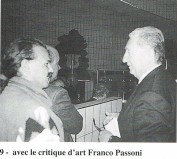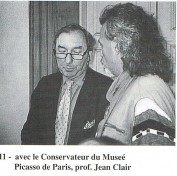
|
of uranian knowledge, whereas androgyny is the first of the divinity's prerogatives. In fact, most of the theogonies imagine a perfect divinity and perfection, in its turn, presupposes an entire personality which benefits from both of the attributes of the two sexes. While in La Gestante we are reminded of the relationship between uranian awareness and the primordial andorgyne, in Chiocciola Superstar (Shell Superstar), a delicate sculptural jewel, it is the close nexus between chthonic knowledge and the eternal feminine which is evoked. A standing, naked girl, with the colour of "golden learning", has just stepped resolutely out of her large shell. This is an archetypal symbol of the creative power of the woman (it is not fortuitous that Venus was born from a shell), charged with an intense erotic valence: its form and labyrinthine profundity evoke the female sexual organ. Two other elements confirm the allegorical value of this work. The shell is a mollusc which like the primordial divinities is hermaphrodite, and the horns on the head of the nude also characterize the goddesses of fecundity. In biblical tradition horns represent the ray and the lightning flash, that is, the light of knowledge. In this way Moses, on having come down from the mountain after having received the tables of knowledge, is often depicted in traditional iconography with two horns which have the appearance of the crescent
|
moon. In the Psalms, when the poet sings the wisdom of King David, he writes that God promises: "There will I make the horn of David to bud" (132:17). Like all archetypal symbols horns have an ambivalent meaning which, in this case, refers us back to the state of the androgynous divinity. In fact, Jung established that the horn rapresents both the active male principle - due to its form and its penetrating power - and the passive, female principle when, as a couple, horns open as receptacle. In Dark Lady3 we see a woman with the face of a hoopoe, in tights but with bared breats, seated on an armchair with her legs wide apart. Without dwelling on the considerable plastic value of the composition, it is important, instead, to point out two details which go towards corroborating the mythical dimension which the female body takes on for Hamlet. The pose of the character irresistibly recalls that of the Delphic Pythia who when she pronounced the oracle was seated on the holmos with her thighs wide open, in this way showing her vulva. This is a position in agreement with that of the pre-Hellenic idols frequently found in auricular places. The stability of this iconographic motif, which has survived practically unchanged for millennia, is testified to by the numerous depictions of the continue
|

